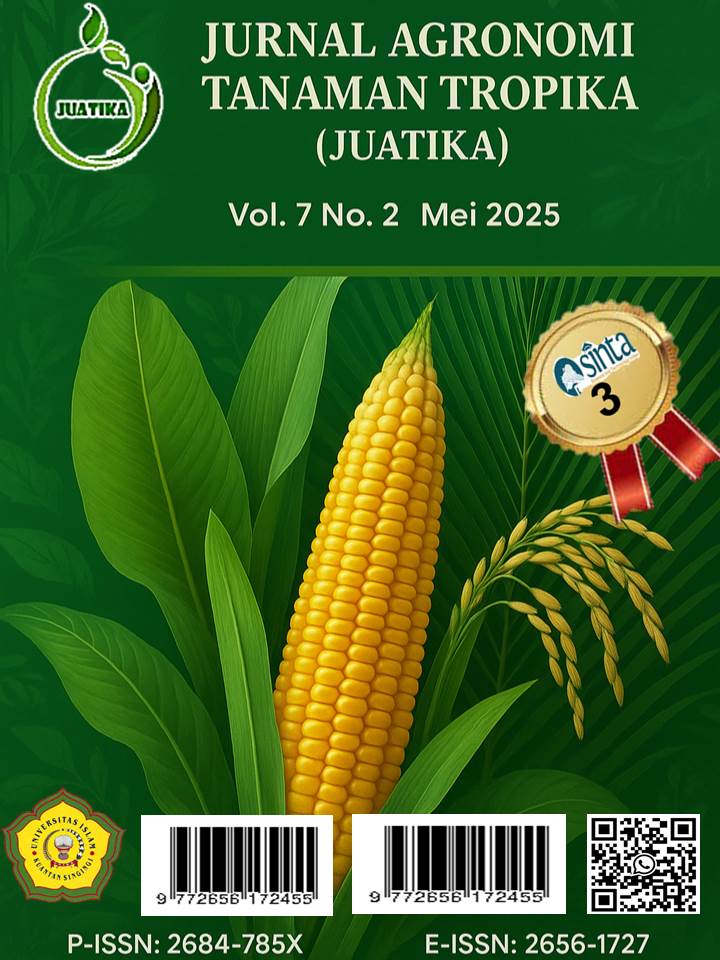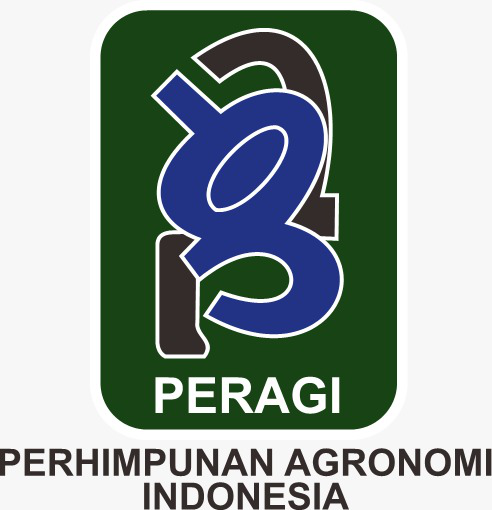The Effect of Growth Regulatory Hormones with Various Concentrations on the Growth of Bentong Ginger Plants Through Tissue Culture
Abstract
The ginger plant is known for its healing and warming properties because it contains various bioactive compounds that provide numerous therapeutic benefits. However, the quality of ginger production has declined due to disease infections. To address this issue, tissue culture techniques are being employed. The purpose of this study was to obtain high-quality ginger planting materials. This research was conducted at MARDI Malaysia, utilizing a completely randomized factorial design consisting of 2 factors. The first factor is hormones comprised of five levels, namely H 1 = GA 3, H 2 = IAA, H 3 = IBA, H 4= NAA and H 5 = BAP The second factor of hormone concentration, consists of five levels, K 1 = control, K 2 = 0.5 ppm, K 3 = 1 ppm K 4 = 1.5 ppm and K 5 = 2.5 ppm. The results of the study showed that the treatment of NAA concentration2.5 ppm had a significant effect on plant height, GA 3 treatment at a concentration of 0.5 ppm, IAA at a concentration of 2.5 ppm, IBA and BAP at a concentration of 1 ppm had a significant effect on the number of leaves, GA 3 treatment at a concentration of 0.5 ppm, IAA at a concentration of 2.5 ppm, IBA and BAP at a concentration of 1 ppm had a significant effect on the number of leaves,0.5 and 1ppm had a significant effect on root length, NAA treatment at concentrations of 0.5 and 1ppm had a significant effect on the number of roots, GA 3 treatment at concentrations of 0.5 ppm had a significant effect on wet weight. root. Hormone GA 3giveinfluenceWhichmoregood for the growth of ginger explants compared to auxin and cytokinin hormones
Downloads
References
Abbas, dan Mohamed, S. (2011). In vitro propagation of ginger (Zingiber officinale Rosco). Journal of Genetic Engineering and Biotechnology, 9(2), 165–172.
Almafri, R. P. (2021). Mikrpropagasi tanaman jahe bunga (Curcuma sp) dengan pemberian benzyl amino purine dan indole butyric acid.
Ardiana, M., Maysyarah, & Advinda, L. (2022). The ability of fluorescent pseudomonad to produce indole acetic acid (IAA). Jurnal Serambi Biologi, 7(1), 59–64.
Arifin, A. Z., Hidayanto, F., & Mahfud, R. I. (2022). The effectiveness of substances in growth regulators on growth of root cutting of mother-in-law’s tongue leaves (Sansevieria trifasciata). Jurnal Agronomi Tanaman Tropika (Juatika), 4(1), 139–146.
Aryanti, I., Eva, S. B., & Emmy, H. K. (2015). 105166-ID-identifikasi-karakteristik-morfologis-da. Jurnal Online Agroekoteknologi, 3(3), 963–975.
Karyanti, et al. (2021). Micropropagation of red ginger (Zingiber officinale Rosc. var. Rubrum) using several types of cytokinins. Journal of Physics: Conference Series, 1751(1).
Saljuna, K. P., Thankamani, C. K., & Pavithran, G. (2024). Application of growth regulators in ginger and turmeric: A review. International Journal of Research in Agronomy, 7(3), 321–328.
Saljuna, K. P., Thankamani, C. K., Krishnamurthy, K. S., Gayathri, P. M., & Alagupalamuthirsola, M. (2023). Effect of growth regulators on the growth and yield of ginger (Zingiber officinale Rosc.) under polyhouse condition. Journal of Plantation Crops, 51(2), 71–76.
Mawaddah, S. K., Saputro, N. W., & Lestari, A. (2021). Pemberian naphthalene acetic acid (NAA) dan kinetin terhadap multiplikasi tunas tanaman jahe (Globba leucantha var. bicolor Holttum) pada kultur in vitro. Bioma: Berkala Ilmiah Biologi, 23(1), 43–50.
Murni, Z., & Turnip, M. (2024). Pertumbuhan kalus dari daun belimbing merah (Baccaurea angulata) dengan penambahan 2,4-D (dichlorophenoxy acetic acid) dan kinetin. Journal of Biological Education and Science, 5(1), 1–14.
Mosie, T. (2019). A review on influence of growth regulator and culture condition on micropropagation of ginger (Zingiber officinale). International Journal of Food Science and Agriculture, 3(3).
Mustafa, I., & Chin, N. L. (2023). Antioxidant properties of dried ginger (Zingiber officinale Roscoe) var. Bentong. Foods, 12(1), 1–18.
Ngadian, & Jayanti, T. (2021). Pengaruh pemberian hormon NAA dan BAP pada media MS (Murashige and Skoog) terhadap pertumbuhan anggrek Vanda tricolor secara in-vitro. Stigma, 14(2), 89–98.
Rikardo, A. S., Martino, T. D., & Sarman. (2019). Pengaruh pemberian auksin (NAA) terhadap pertumbuhan tunas tajuk dan tunas cabang akar bibit karet (Hevea brasillensis Muell. Arg) okulasi mata tidur. Agroecotenia, 2(2), 11–20.
Sarno. (2019). Pemanfaatan tanaman obat (biofarmaka) sebagai produk unggulan masyarakat Desa Depok Banjarnegara. Abdimas Unwahas, 4(2), 73–78.
Putri, F. F., Susanti, R., Nazreena, A. N., & Ab Rahman, Z. (2025). Induction and regeneration of ginger callus (Zingiber officinale) in Malaysia by administration of 2,4-D and NAA.
Wahyuningsih, S., Serdani, A. D., Kurniastuti, T., & Widiatmanta, J. (2023). Pengaruh konsentrasi dan frekuensi pemberian zat pengatur tumbuh giberelin (GA₃) terhadap pertumbuhan dan hasil tanaman terung (Solanum melongena L.) varietas Mustang F1. Seminar Nasional Peran Petani Milenial dalam Pembangunan Pertanian Menuju Kedaulatan Pangan Berkelanjutan, 59–65.
Walid, A., Ahmad, F. T., & Ismarliana. (2020). Ekologia: Jurnal Ilmiah Ilmu Dasar dan Lingkungan Hidup. Ekologia: Jurnal Ilmiah Ilmu Dasar dan Lingkungan Hidup, 20(1), 40–44.
Zahid, N. A., Jaafar, H. Z. E., & Hakiman, M. (2021). Micropropagation of ginger (Zingiber officinale Roscoe) ‘Bentong’ and evaluation of its secondary metabolites and antioxidant activities compared with the conventionally propagated plant. Plants, 10, 630.
Copyright (c) 2025 Arman Alfarizi, Sri Utami, Zuraida Ar rahman

This work is licensed under a Creative Commons Attribution 4.0 International License.
Authors who publish with Jurnal Agronomi Tanaman Tropika (JUATIKA) agree to the following terms:
Authors retain copyright and grant the Jurnal Agronomi Tanaman Tropika (JUATIKA) right of first publication with the work simultaneously licensed under a Creative Commons Attribution License (CC BY 4.0) that allows others to share (copy and redistribute the material in any medium or format) and adapt (remix, transform, and build upon the material for any purpose, even commercially) with an acknowledgment of the work's authorship and initial publication in Jurnal Agronomi Tanaman Tropika (JUATIKA).
Authors are able to enter into separate, additional contractual arrangements for the non-exclusive distribution of the journal's published version of the work (e.g., post it to an institutional repository or publish it in a book), with an acknowledgment of its initial publication in Jurnal Agronomi Tanaman Tropika (JUATIKA). Authors are permitted and encouraged to post their work online (e.g., in institutional repositories or on their website) prior to and during the submission process, as it can lead to productive exchanges, as well as earlier and greater citation of published work.







 More Information
More Information



